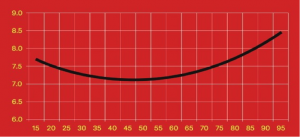The December 2014 edition of The Atlantic contains an interesting article entitled “The Real Roots of Midlife Crisis” by Jonathan Rauch. In it, he notes that mid-life crisis is not a unique reality to the United States. Rather, it is a worldwide phenomenon explained by science and more particularly the “U” or happiness curve. (See graph below.)
Typically, when we are in our 30s and 40s, we feel that we are on top of the world (or slowly but surely getting there) moving forward and upwards in our personal and business lives. We are establishing ourselves both personally and professionally, gaining more responsibility (and thus hopefully more financial remuneration) in our professional lives and creating more stable long term relationships personally (family and kids). Hopefully, we are also healthy and so feel that we have all that we dreamed of when we were in our twenties and just starting out.
But then, as we enter our early to mid 40s, we begin to wonder “Is this it?”; “Is this all there is to life?” We suddenly realize that there may be more years of our lives behind us than in front of us. We begin to feel a little bit ungrateful, and small things start nagging at us- both physically and emotionally. We no longer feel invincible or immortal. The ordinariness and routines of life suddenly begin to gnaw at us. We think, “There has got to be something better!”
This “sinking” feeling continues for a few years, often into our 50s. At this point, we may hit some down sides to life; the death of loved ones, divorce, loss of employment, or loss of a home et cetera. It seems that the disappointments begin to mount up and continue.
But, somehow, as we reach the late 50s, our perspective on life changes. Our values seem to change, and we begin to enjoy life again, and as we age, we become more content such that the older we get, the “happier” with life we become.
What I have described is the “U” curve of life (aka the “happiness” curve). Beginning in the 1970s, Richard Easterline, then an economist at the University of Pennsylvania, studied surveys that gauged peoples’ happiness in countries around the world. What he found was that “… beyond a certain point, countries don’t get happier as they get richer.” (Known as the Easterlin paradox.) (Id. at 2.)
Then in the 1990s, this area of economics became in vogue once again (i.e., “happiness economics”). Various researchers conducted studies on the relationship between work and happiness in various countries around the world. This research slowly shifted to looking into peoples’ satisfaction with life. They found a recurrent theme:
“…life satisfaction would decline with age for the first couple of decades of adulthood, bottom out somewhere in the 40s or early 50s, and then, until the very last years, increase with age, often (though not always) reaching a higher level than in young adulthood. The pattern came to be known as the happiness U-curve.” (Id. at 2.)
In a 2008 study of 80 countries, researchers David Blanchflower of Dartmouth and Andrew Oswald of the University of Warwick found that people in 55 of these countries tended to bottom out on the “happiness” curve, or reach the bottom of it at about age 46 . (Id. at 3.) Other “…studies show quite strongly that people’s satisfaction with their life increases, on average, from their early 50s on through their 60s and 70s and even beyond—for many until disability and final illness exact their toll toward the very end….” (Id. at 6.)
Why? As alluded to by Stanford psychologist Laura Carstensen and her colleagues in a 2011 paper:
“As people age and time horizons grow shorter,” they write, “people invest in what is most important, typically meaningful relationships, and derive increasingly greater satisfaction from these investments.” Midlife is, for many people, a time of recalibration, when they begin to evaluate their lives less in terms of social competition and more in terms of social connectedness. …“
In short, we recalibrate as we age, and our perspective changes. What may have been important to us in our 30s and 40s – career and upward mobility- no longer matters. As we age, family and relationships become the focus.
 (Id at 11.)
(Id at 11.)
Thus, how we negotiate, (as well as what we negotiate about) and how our needs and interests are met in any dispute will vary with our age due to our perspective and location on the “U” curve. What may be important to a 30-something year old plaintiff or defendant may well not even be on the radar of a 60 something year old plaintiff or defendant. So, in any dispute, age DOES matter. Where one is on the “happiness” curve will affect the negotiation and its outcome. The same may be said for the particular neutral mediating the dispute; no doubt where she is on the curve may well affect her mediation style. Both are definitely something to consider.
…. Just something to think about.
-------------------------------------
Do you like what you read?
If you would like to receive this blog automatically by e mail each week, please click on one of the following plugins/services:
and for the URL, type in my blog post address: http://www.pgpmediation.com/feed/ and then type in your e mail address and click "submit".
Copyright 2021 Phyllis G. Pollack and www.pgpmediation.com, 2021. Unauthorized use and/or duplication of this material without express and written permission from this site’s author and/or owner is strictly prohibited. Excerpts and links may be used, provided that full and clear credit is given to Phyllis G. Pollack and www.pgpmediation.com with appropriate and specific direction to the original content.


